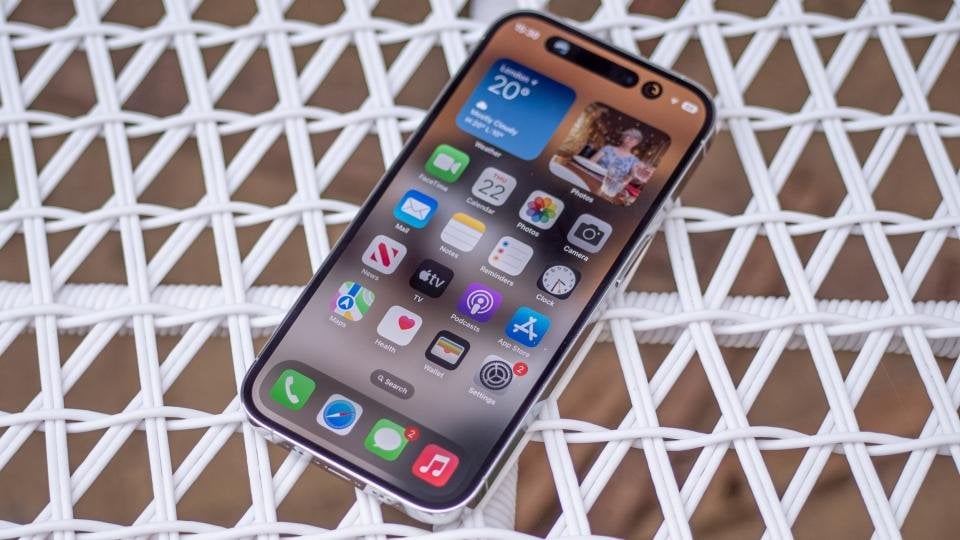
The iPhone 14 Pro is an improvement but not a huge leap forward
Pros Always-On display is wonderfulProRAW 48MP main camera is a major advanceCons More expensive than last yearStill no USB-C
If there’s one thing the iPhone 14 Pro has to battle against, it’s boredom. Boredom with the annual upgrade cycle, boredom with the lack of radical updates. And boredom with Apple phones being so consistently good year after year.
Alas, if you’re desperate to hear that Apple has somehow messed up and forgotten what makes a smartphone great, I’m afraid you’re going to be disappointed. The iPhone 14 Pro is all those things mentioned above and then some. It’s slightly better than the iPhone 13 Pro (£949) in all the important ways: it’s faster, lasts longer and captures superior photographs and video than last year’s phone.
Apple iPhone 14 Pro review: What you need to know
With all of those boxes ticked, you’d have forgiven Apple for stopping right there, pushing the prices up a touch and moving on. In some ways, it looks like Apple has done just that.
The iPhone 14 Pro is the same size and shape as last year’s phone, with a 6.1in Super Retina XDR OLED display and a near-identical look and feel. The camera bump is larger, which means cases for the iPhone 13 Pro won’t fit but, otherwise, there’s nothing new here.
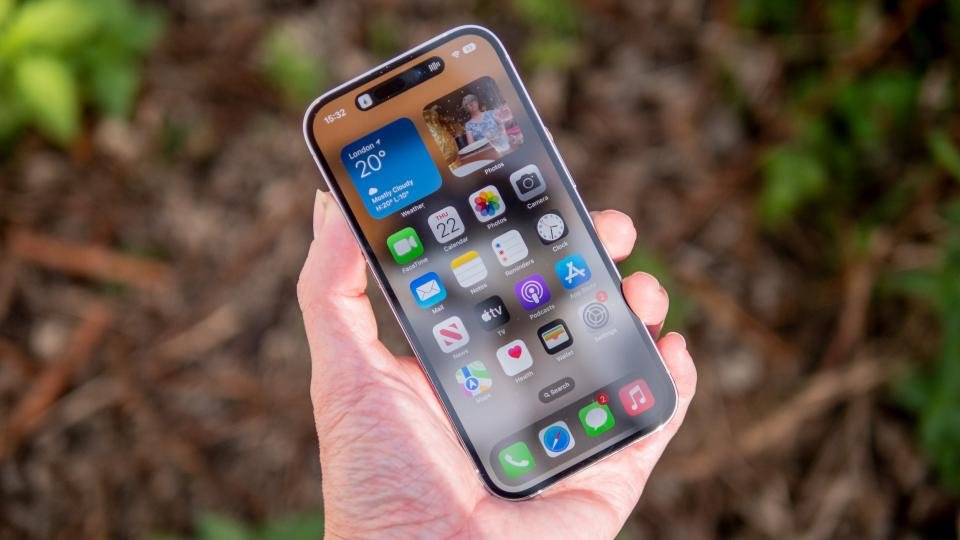
However, the iPhone 14 Pro does arrive with a couple of new features that set it apart from recent models and they’re pretty big ones. The Dynamic Island – possibly the “most Apple” name for a feature I think I’ve ever seen – sees the much-maligned selfie notch shrunk in shape and integrated into the notification system (more on that later).
Apple’s Always-On display, meanwhile, takes a feature much beloved of Android smartphone owners and makes it even better, allowing users to not only display important info on the lock screen in standby but also – thanks to new display tech – photographs or background wallpapers.
And, while not obvious, the iPhone 14 Pro also offers a whole host of camera improvements. There’s a 65% larger, 48MP resolution sensor for the main camera. The ultrawide sensor is twice as large, too, and it also has a wider aperture to allow more light in. The selfie camera at the front now has autofocus and a brighter aperture as well.
Improvements to computational photography mean the processing of low-light images is better, while the iPhone 14 Pro gains a brand new way of shooting. Action Mode, as Apple calls it, attempts to simulate the smooth, shake-free video recording possible with the best action cameras.
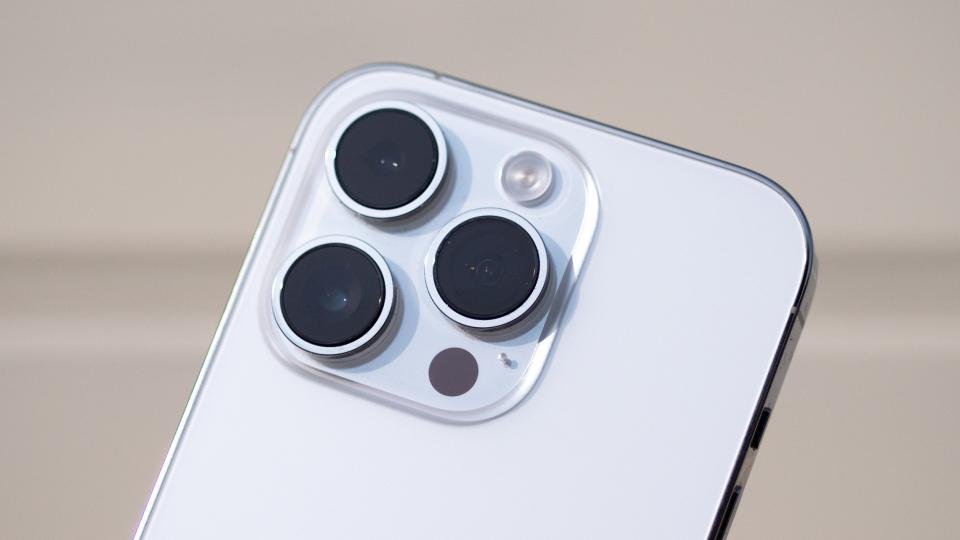
Other upgrades include the widely anticipated move to the 4nm A16 Bionic chipset, car crash detection and a new satellite emergency SOS system (although this is only available in the US and Canada initially).
What Apple hasn’t done this year – again – is introduce USB-C charging, with the iPhone 14 Pro still featuring a Lightning connector on its bottom edge. The much-rumoured Touch ID sensor hasn’t materialised, either, while in Europe and the UK we still get a SIM tray. Only US users are losing that this year.
Apple iPhone 14 Pro review: Price and competition
On paper, then, the iPhone 14 Pro offers a fairly significant number of upgrades this year. Unfortunately, Apple has also bumped up the price, with the 128GB iPhone 14 Pro costing £1,099 – that’s £150 more expensive than the base model was last year. The 256GB 14 Pro costs £1,209, the 512GB model is £1,429 and the one with 1TB storage is a rather daft £1,649.
Even in the rarefied atmosphere of the premium smartphone market, this is a LOT of money for a handset with a 6.1in screen. It’s only £50 less than the Samsung Galaxy S22 Ultra (£1,149), which has a bigger 6.8in display, a longer 10x telephoto zoom and bundled S Pen stylus.
It’s about the same price as the Oppo Find X5 Pro (£1,049), too, which also has a larger display (6.7in) and comes with an exotic triple camera setup. The main 50MP camera module has dual sensor/lens shift OIS to iron out hand shake, while the ultrawide camera has an unusually high resolution, matching the 50MP resolution of the main camera.
And it’s actually more expensive than Samsung’s entry-level clamshell folding phone, the Galaxy Z Flip4 (£999). In other words, there are plenty of more attractive alternatives at around the same price. If you’re willing to make the move to Android, that is.
![OPPO Find X5 Pro 5G Smartphone, Snapdragon 8 Gen 1, 6.7'' AMOLED WQHD+ 120Hz, 50MP dual primary cameras, 4K Ultra Night Video, 12GB + 256GB, 5000mAh 80W Supervooc, IP68 [UK Version], Glaze Black Image of OPPO Find X5 Pro 5G Smartphone, Snapdragon 8 Gen 1, 6.7'' AMOLED WQHD+ 120Hz, 50MP dual primary cameras, 4K Ultra Night Video, 12GB + 256GB, 5000mAh 80W Supervooc, IP68 [UK Version], Glaze Black](https://techgit.net/wp-content/uploads/2023/02/416ofiPMajL-1113789-6684235._SL160.jpg)
OPPO Find X5 Pro 5G Smartphone, Snapdragon 8 Gen 1, 6.7” AMOLED WQHD+ 120Hz, 50MP dual primary cameras, 4K Ultra Night Video, 12GB + 256GB, 5000mAh 80W Supervooc, IP68 [UK Version], Glaze Black
Apple iPhone 14 Pro review: Design and features
Physically, there’s nothing particularly remarkable about the iPhone 14 Pro, but it would be churlish to criticise too much. The iPhone 13 Pro was a handsome thing and although we’re more familiar with it, this year my opinion hasn’t changed.
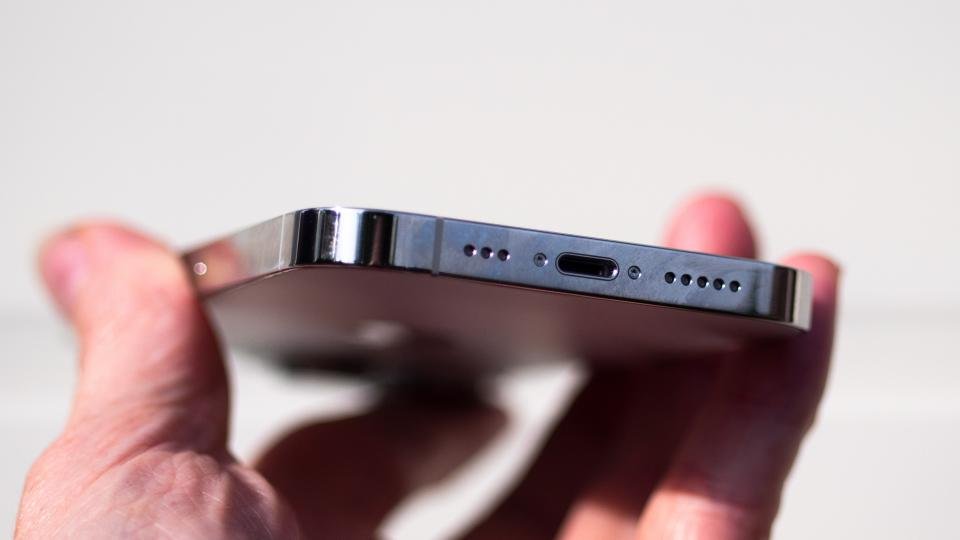
All of the critical design details remain the same. The flat-edged stainless steel band wrapping around the circumference is still in place as is the finely ground matte glass at the rear and the super tough “Ceramic Shield” glass at the front. I can vouch for this, too, since despite using an iPhone 13 Pro for a year now without a screen protector, there’s not a single scratch to be seen on the front glass.
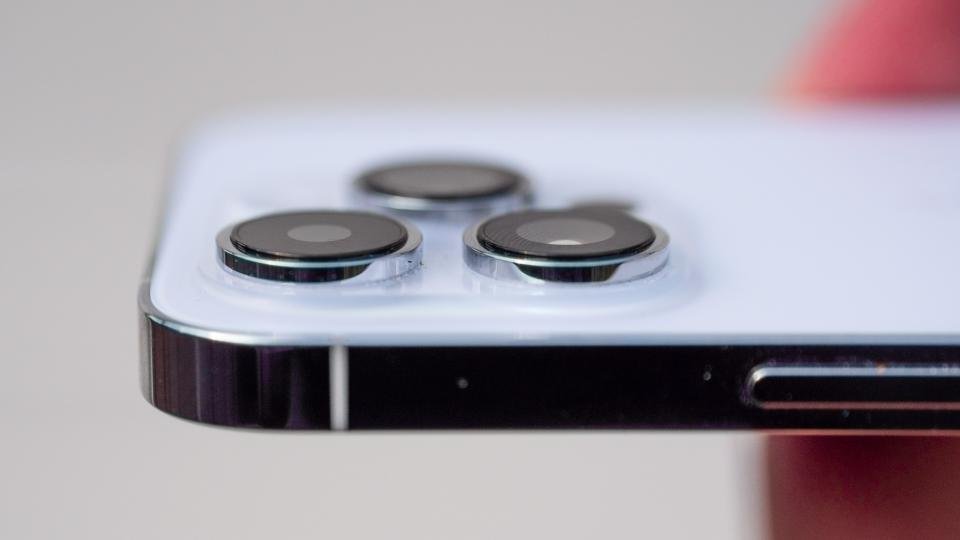
The camera bump is fractionally larger and taller than before, although that doesn’t have a material impact on usability. You’ll still need to buy a case to fit, otherwise, it will teeter to and fro when you place it on a flat surface. It’s slightly taller (by 0.8mm) and a tiny bit thicker, too (by 0.2mm) and the phone is, as it was previously, IP68 rated, which means in this case that it can be submerged in up to six metres of water for up to 30 minutes.
Apple iPhone 14 Pro review: Dynamic Island and Always-On display
Of course, the big new thing this year is that the old bathtub notch has been removed and replaced by two, more space-efficient cutouts: one for the infrared projector and camera and the other for the new selfie camera. The 14 Pro’s screen surrounds them above, below and in-between.
This is Apple’s infamous “Dynamic Island”, so called because Apple has integrated the cutouts into a new notification and status system. It’s an ingenious idea, too. Instead of simple dead space, the area around and between the cameras expands and contracts to reflect everything from music and timers, to notifications and even directions from Apple Maps.
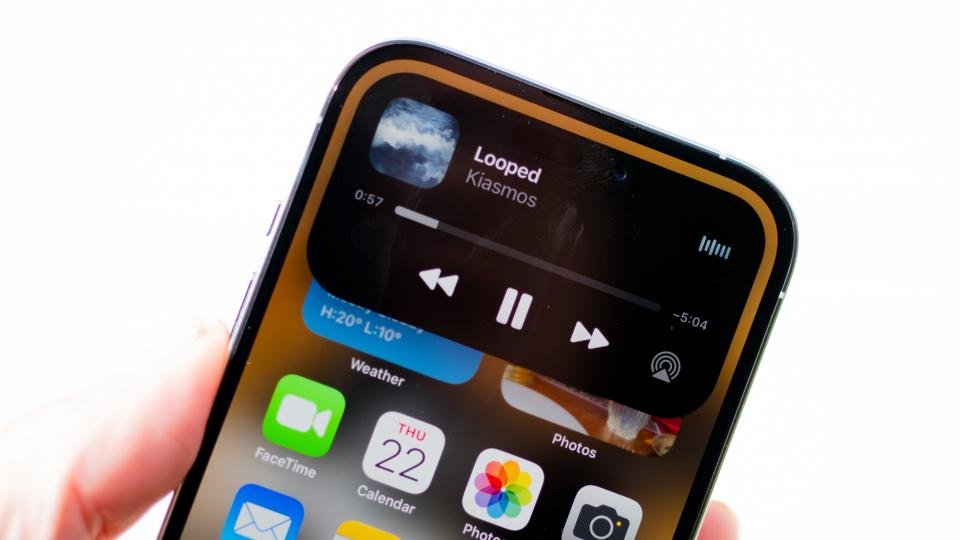
It’s interactive – you can tap the Island to access the app in question or long press to get a preview and even some basic controls – and it’s also open to third-party developers, which means it’s not only core Apple apps that have access to it. Cue up a track on Spotify and you’ll see a tiny thumbnail of what’s currently playing to the left, along with a tiny animated graphic EQ to the right. Long press that and a larger box pops up with a selection of controls, allowing quick access to skip, play and pause buttons. You can even scrub back and forth on the timeline and send audio to a HomePod or Apple TV.
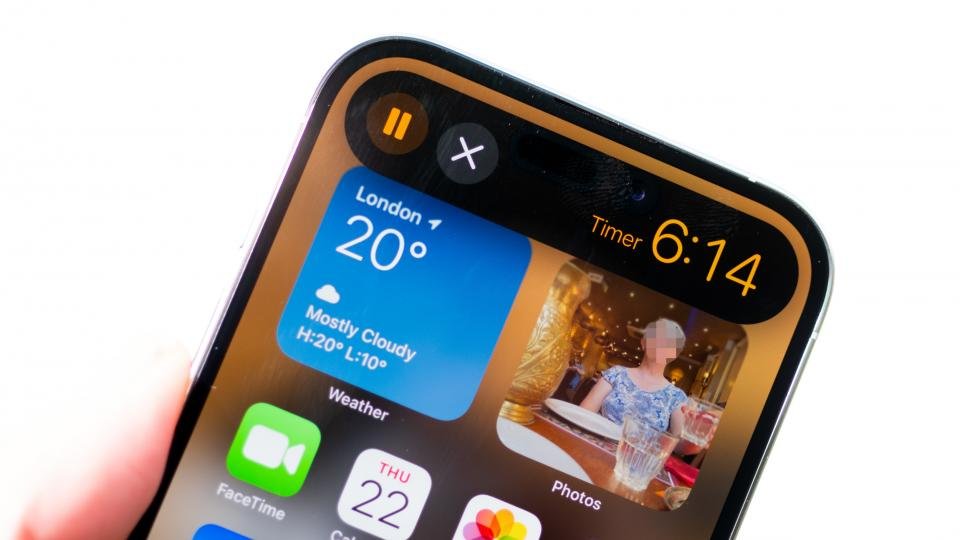
It’s a small thing, quite literally, but it soon feels utterly natural in day-to-day use and although it doesn’t have a huge impact on usability, there’s a palpable sense of delight the first few times you see it in action.
Apple’s Always-On display is an even bigger deal. Enabled by the new ProMotion adaptive refresh technology built into the screen, it can redraw what’s on-screen at a rate of 1Hz (one refresh per second), thus keeping power requirements low and minimising the impact on battery life. And, in typical Apple fashion, it goes several steps further than what you’ll see on rival Android handsets.
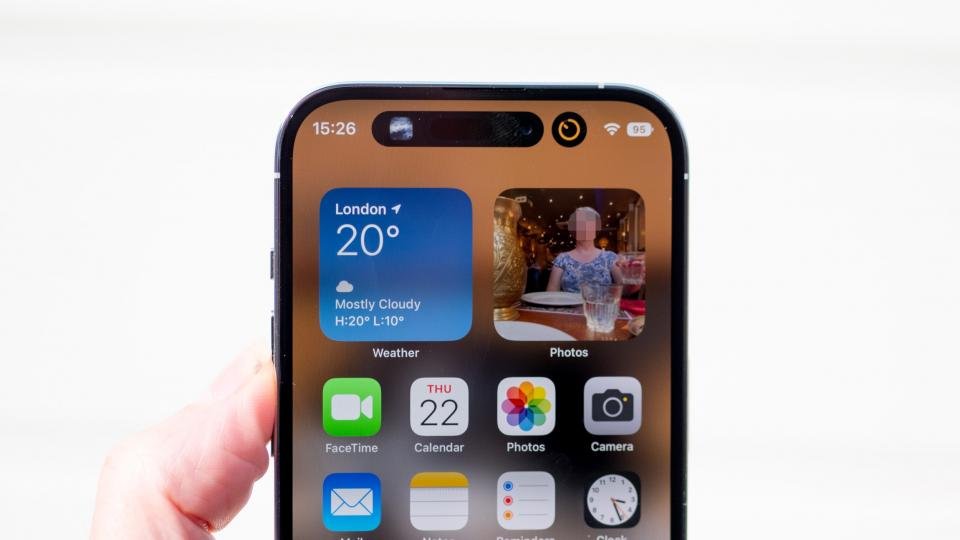
Not only can it display the time, date and notifications so you can keep up to date without having to pick up your phone and unlock it as frequently as you do now, but it can also show a far richer palette of information. This includes widgets for weather and your calendar, plus cards for background tasks like timers and music.
More than that, though, it can even display wallpaper or photographs from your library in full screen and it will dim and brighten depending on the ambient light, keeping it just bright enough to be visible.
These aren’t, of course, the only innovative new features coming to the iPhone 14 Pro. There’s also crash detection – the phone will use its sensors to detect if you’ve been in a car crash, automatically call emergency services and even play a recorded message to the operator for you if you’re unresponsive – and something called Emergency SOS via satellite. The latter is only available in the US and Canada at launch but the idea is simple enough: the phone is able to send very short SOS emergency messages via satellite if you get in trouble when you’re out of cellular contact. Alas, there’s no word yet on when, or whether, this feature will come to other territories but don’t expect it to be free in perpetuity. Even though there will be no cost associated with the service initially in the US, Apple plans to charge for it after that.
Apple iPhone 14 Pro review: Display
Given how much work must have gone into the Dynamic Island and Always-On display, you might have forgiven Apple for leaving the display improvements at that. But that isn’t the case here, with Apple beefing up HDR courtesy of increased maximum brightness.
You could argue that a peak HDR brightness of 1,300cd/m2 was good enough but the new display can now reach a claimed 1,600cd/m2 in video playback. For the first time, it can also blast past that in normal use and go as high as 2,000cd/m2 when you’re using the phone in really bright ambient conditions.
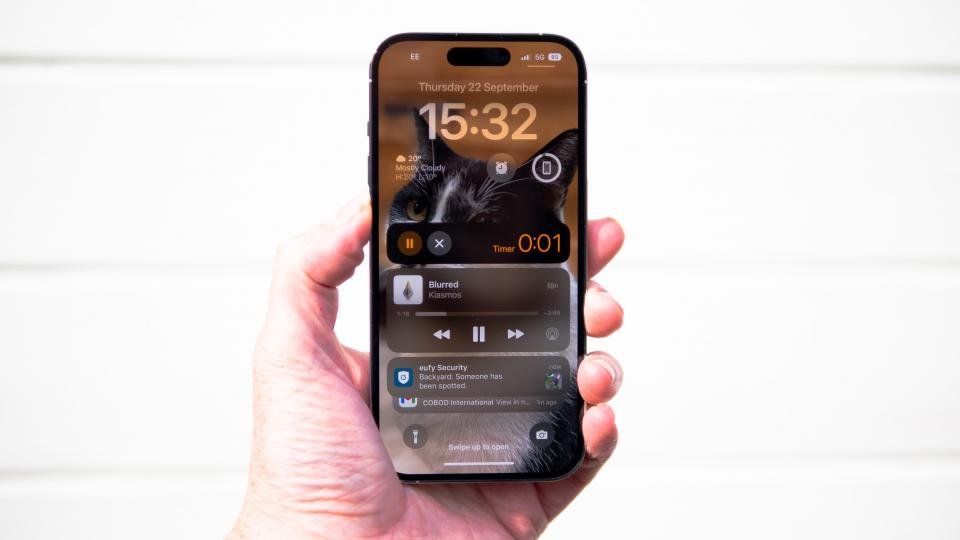
In testing, I was able to hit these figures and a bit more, recording up to 1,629cd/m2 when viewing HDR video and a positively blinding 2,272cd/m2 maximum overall. It should be noted that, just as with HDR video playback, only part of the screen will ever output at these levels; if you’re displaying a web page with black text against a mostly white background, brightness will be capped at around 1,000cd/m2. Slightly counterintuitively, that means the new iPhone is at its most readable in super bright conditions when you switch it into dark mode.
Elsewhere, the display is thoroughly brilliant. It’s colour accurate, with an impressive Delta E of 1 versus sRGB, and it looks absolutely phenomenal when playing HDR video material, whether that be home movies shot on the iPhone’s Dolby Vision rear cameras or Dolby Vision TV shows on Disney Plus.
But then the iPhone 13 Pro’s display was already excellent. I put the 13 Pro right next to the 14 Pro and played back an episode of The Mandalorian at the same time on both phones and, while there was clearly a difference, it wasn’t a night and day benefit.
Apple iPhone 14 Pro review: Cameras
The same applies to the iPhone 14 Pro’s camera system. In daily shooting, I haven’t seen a huge amount of improvement in image quality over the iPhone 13 Pro. It certainly looks good on paper and it is generally better but this isn’t a huge leap forwards.
It’s clear that a lot has changed in terms of componentry, however. The main camera has had a massive resolution boost from 12MP to 48MP and the sensor is also 65% larger than before, although note that the aperture is a slightly dimmer f/1.8 compared with f/1.5 previously. The 12MP ultrawide camera’s sensor is almost twice as big, too, and Apple’s TrueDepth selfie camera benefits from both autofocus and a brighter f/1.9 aperture.
The only camera module that hasn’t seen any kind of improvement is the 12MP 3x telephoto. It still has an aperture of f/2.8, an equivalent focal length of 77mm and a sensor size of 1/3.5in.
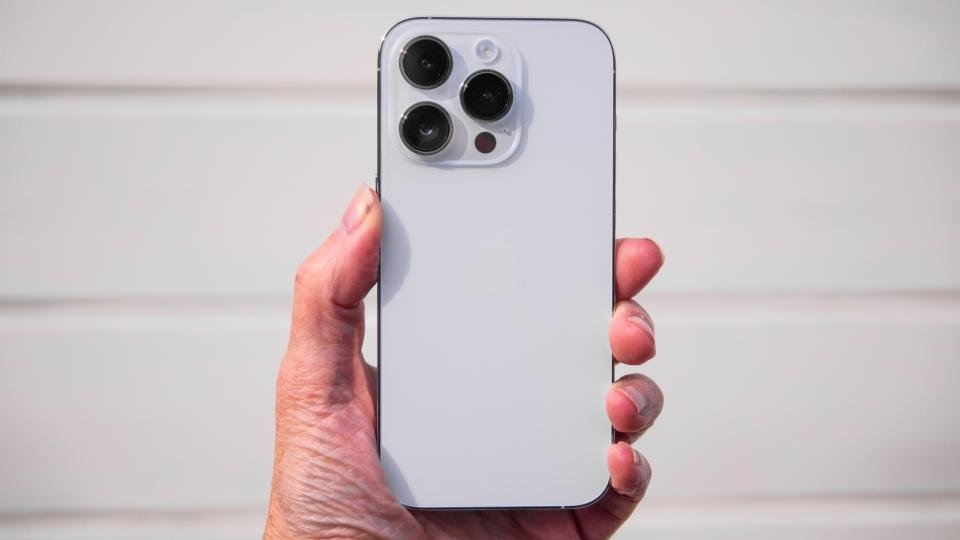
There are other changes, too. The sensor-shift optical image stabilisation system is now into its second generation. Apple says it has improved the way it processes low- and mid-light images, by applying its “Deep Fusion” tech further up the imaging pipeline.
There’s a whole raft of new and upgraded features on the video front as well. Last year’s Cinematic mode is no longer restricted to 1080p and can now be captured in 4K resolution. There’s the all-new Action Mode, too, which applies action camera-like stabilisation to video footage (more on this below).
One thing to get out of the way early doors is that the 48MP sensor doesn’t produce 48MP images by default. Instead, like most other smartphones that employ high-resolution sensors, Apple uses pixel binning, combining four pixels into one to reduce the resolution to 12MP and, in theory, producing superior image quality. You can judge for yourself by the samples below but the difference in most circumstances is minimal.
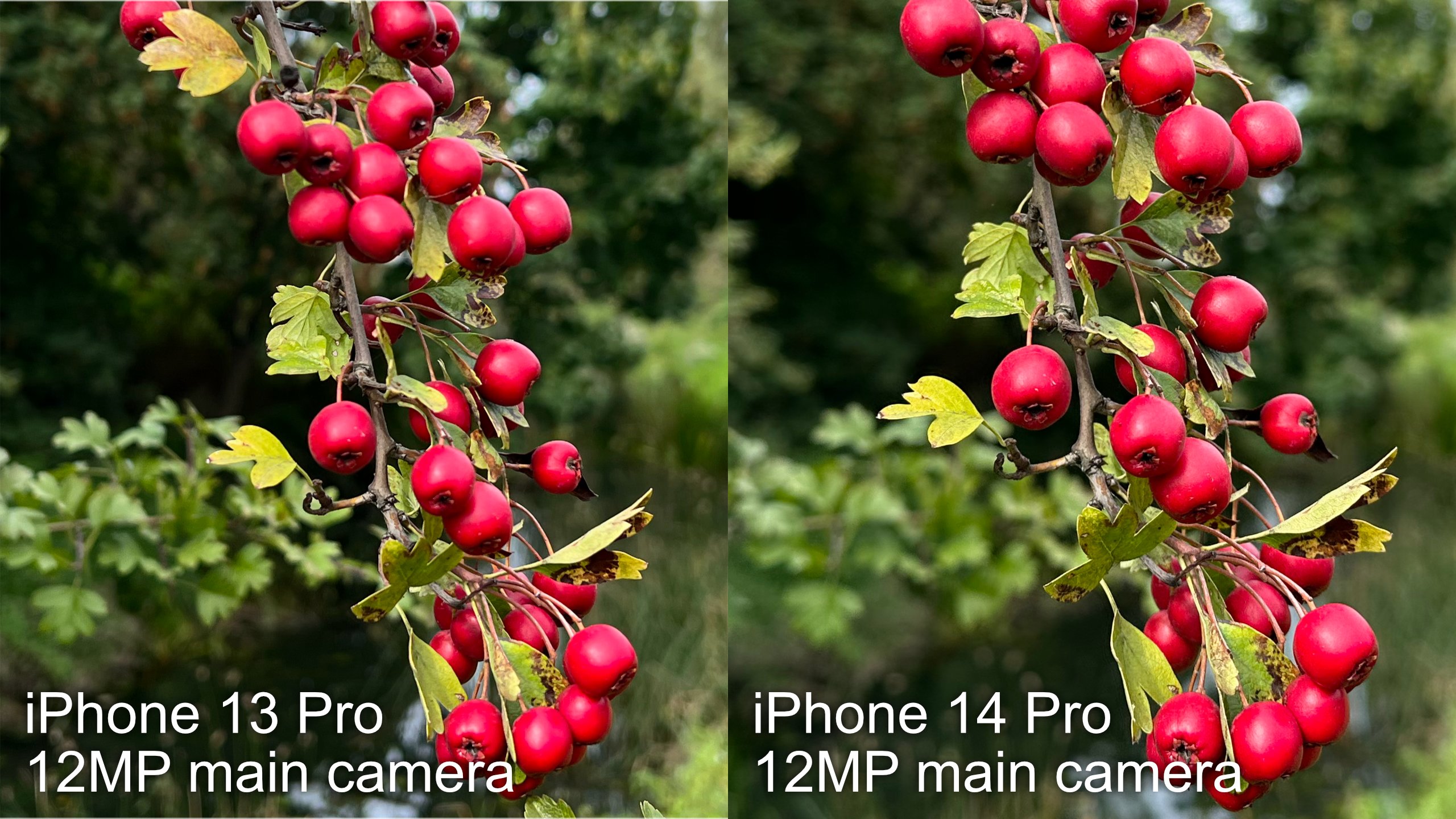 In good light, I noticed the iPhone 14 Pro captured colours that looked a touch less yellow and more neutral but detail levels in good light and low light seemed to be largely the same.
In good light, I noticed the iPhone 14 Pro captured colours that looked a touch less yellow and more neutral but detail levels in good light and low light seemed to be largely the same.
In some images, however, it did seem that the new “Photonic Engine” processing had made a difference. In the below image of the church, for example, the iPhone 14 Pro has far more detail in the grass in the foreground.
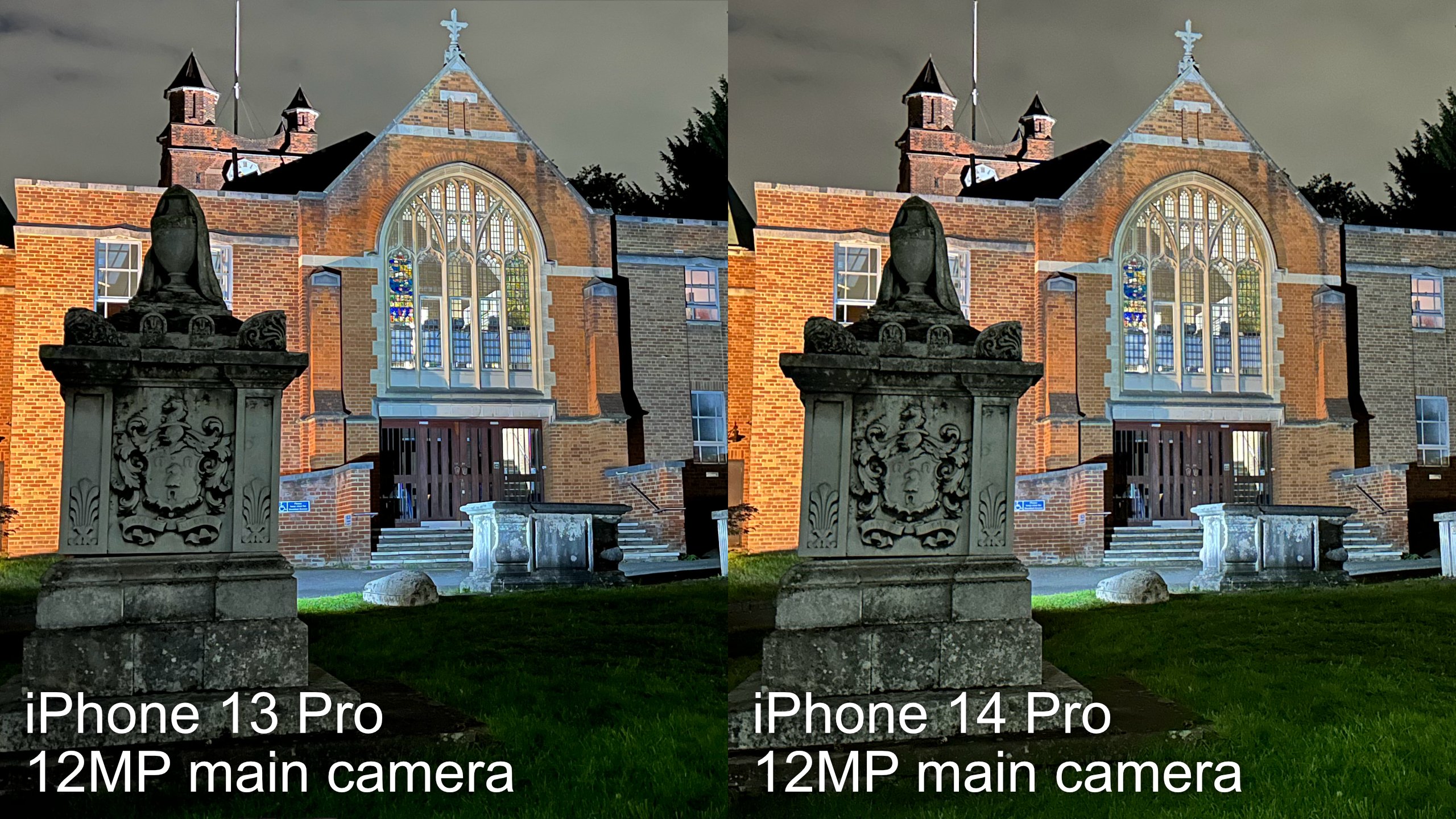 You see the biggest difference when you capture your images in ProRAW format. To do this, you need to enable the feature in the camera’s settings menu, then tap the RAW toggle button in the camera app before taking a photograph. In this mode, the camera captures full-res 48MP images and the difference in detail capture is simply stunning – just look at the close-up comparisons below – the ProRAW image, processed in Photoshop, has a huge amount more fine detail than the 12MP image shot in default mode.
You see the biggest difference when you capture your images in ProRAW format. To do this, you need to enable the feature in the camera’s settings menu, then tap the RAW toggle button in the camera app before taking a photograph. In this mode, the camera captures full-res 48MP images and the difference in detail capture is simply stunning – just look at the close-up comparisons below – the ProRAW image, processed in Photoshop, has a huge amount more fine detail than the 12MP image shot in default mode.
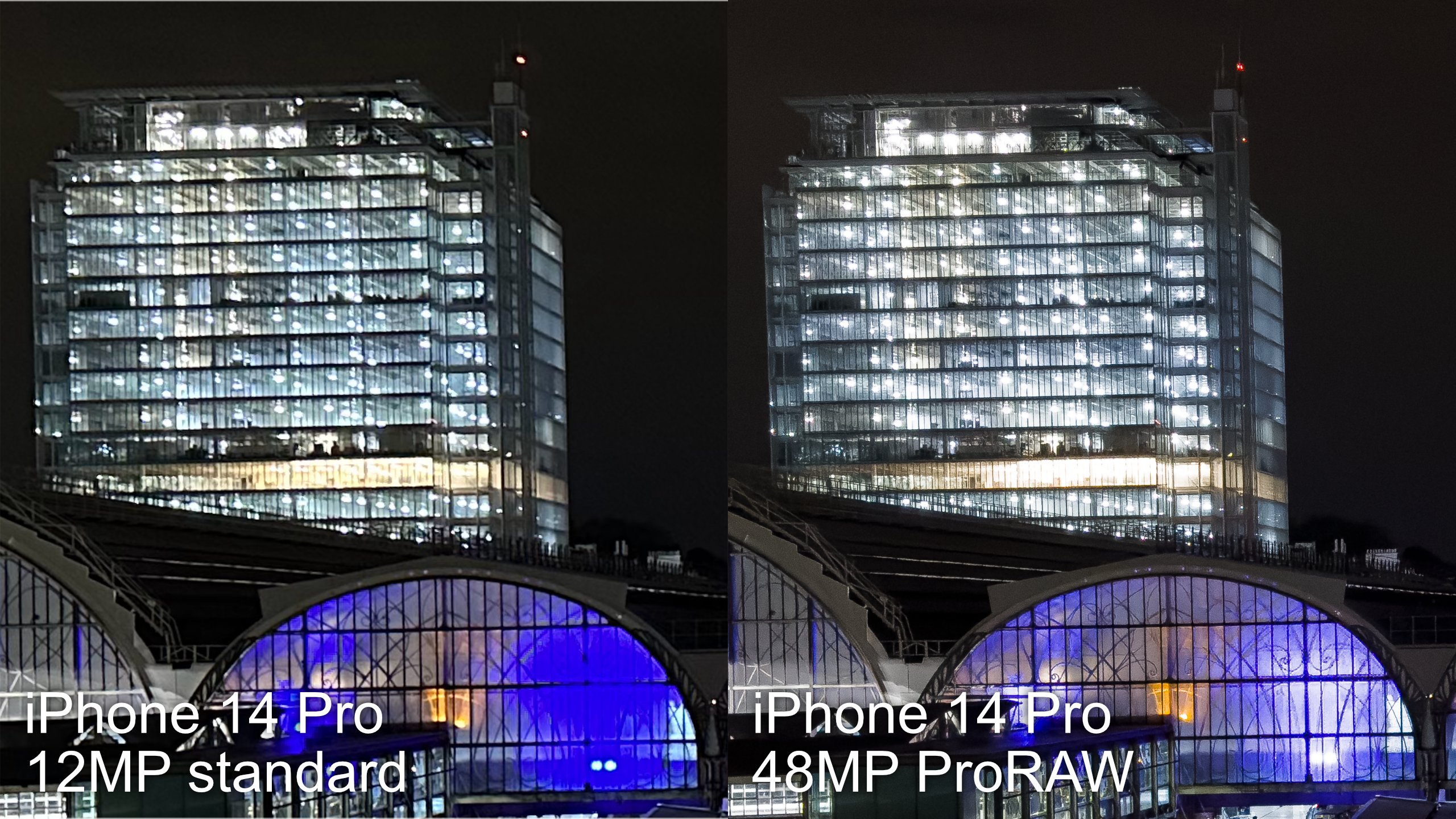 Even after resizing the 48MP image down to 12MP there’s still a huge amount more detail in the ProRAW image. The only negative is that the images do occupy much more space in your iPhone’s storage – at around 73MB per photograph in ProRAW versus a mere 1.4MB – and you’ll only get the most out of them if you process them yourself carefully but if you don’t mind doing that, then I can’t imagine shooting in any other way on the iPhone 14 Pro.
Even after resizing the 48MP image down to 12MP there’s still a huge amount more detail in the ProRAW image. The only negative is that the images do occupy much more space in your iPhone’s storage – at around 73MB per photograph in ProRAW versus a mere 1.4MB – and you’ll only get the most out of them if you process them yourself carefully but if you don’t mind doing that, then I can’t imagine shooting in any other way on the iPhone 14 Pro.
The ultrawide camera exhibits slightly less of a dramatic improvement but there it is better, especially in low light where it captures slightly crisper, cleaner and less noisy images.
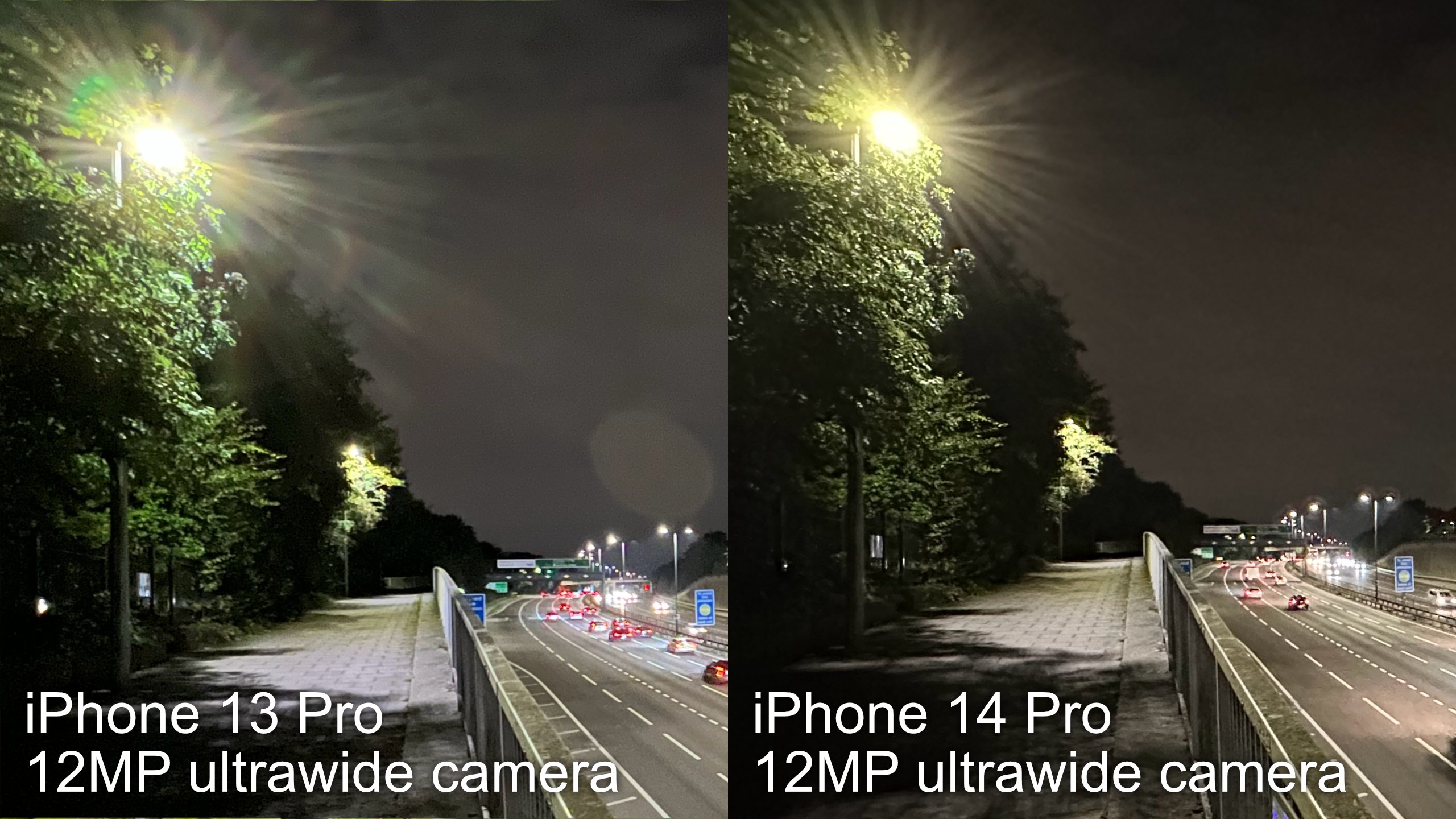 It’s the new selfie camera that exhibits the least benefit, however, though the ability to autofocus should improve the ratio of hits to misses over time.
It’s the new selfie camera that exhibits the least benefit, however, though the ability to autofocus should improve the ratio of hits to misses over time.
The iPhone continues to be the best smartphone around for video capture as well. There’s no 8K capture – that’s not particularly useful for the vast majority of users, anyway – but the new Action Mode is genuinely impressive. I compared it directly against a GoPro Hero10 Black filming while I was walking and running, with footage looking just as smooth as on the dedicated action camera.
This doesn’t turn your iPhone into an action camera, of course (it’s not tough enough for that) and the GoPro can deliver its ultra-smooth video at the much higher resolution of 5.3K 60fps whereas the iPhone 14 Pro is capped at 2.8K 60fps. However, it’s an impressive feat nonetheless and the fact that it records in Dolby Vision HDR means as long as it’s viewed on a suitable screen, your video will look absolutely stunning.
Apple iPhone 14 Pro review: Performance
The iPhone 14 Pro comes, as you’d expect, with a new Apple chipset inside and this – the A16 Bionic – delivers performance gains that are precisely in line with previous iPhone iterations. It’s a hexa-core processor with a pair of performance cores running at 3.5GHz and four efficiency cores running at up to 2GHz and is built on a 4nm fabrication process.
Apple says the A16 Bionic also brings 50% more memory bandwidth than the A15 Bionic, which supposedly helps with GPU performance, while a revamped ISP (image signal processor) enables improved camera performance (see above).
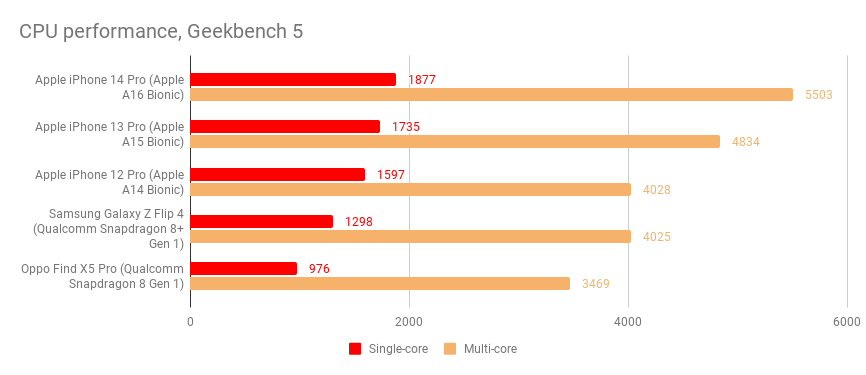
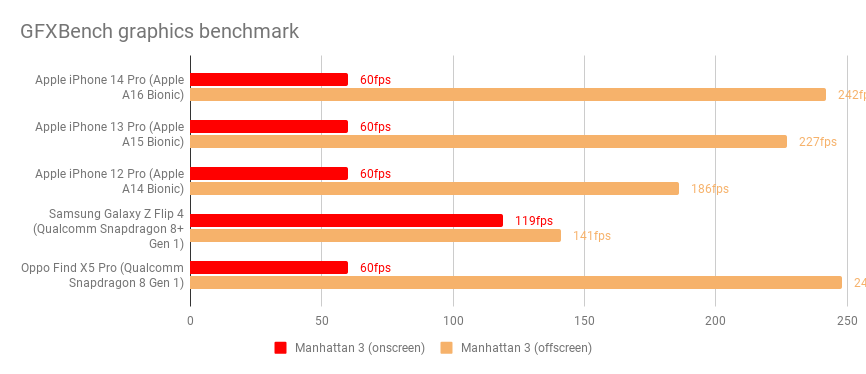
In the various benchmarking tools we use, the A16 Bionic delivers better results across the board but there’s nothing out of the ordinary here. Last year’s A15 Bionic delivered similar improvements in both GPU and CPU-related tasks, as did the A14 Bionic before that.
What’s perhaps more interesting is that Snapdragon-based smartphones are finally catching up when it comes to GPU performance. If not CPU speeds, where – slightly embarrassingly – the iPhone 12 Pro is still faster than the fastest Android has to offer. This is presumably why Apple isn’t too worried about leaving the non-Pro iPhone 14 on the A15 Bionic this year – it’s still perfectly fast for most people.
Battery life hasn’t improved, per se, but it hasn’t at least got worse. In our video test, which we run with the phone in flight mode and the screen set to a brightness level of 170cd/m2, it lasted a respectable 20hrs 40mins. Give or take a minute, this is the same as the iPhone 13 Pro last year.
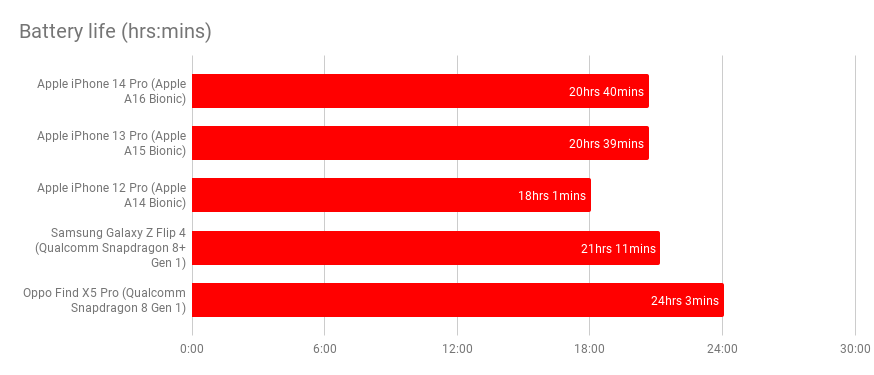
The Always on Display doesn’t appear to have an impact on real-world battery life, either. I haven’t admittedly been using the phone very long but initial impressions indicate that it’ll easily last a day and more with moderate use.
Apple iPhone 14 Pro review: Verdict
No two ways about it, the Apple iPhone 14 Pro is an impressive smartphone. In terms of its camera, performance and features it’s a better phone than last year’s iPhone 13 Pro (£949) and it doesn’t get anything badly wrong either, except perhaps the fact that it’s still stuck with Lightning connectivity.
The price has gone up, which you’d expect in the current climate, but not by swingeing levels, and Apple has introduced a handful of fairly significant usability and safety improvements including Dynamic Island, the Always-On display, crash detection and SOS via satellite (although only in the US and Canada right now).
In many ways, this makes it the very epitome of an iterative Apple iPhone release. It’s boring, yes, and expensive of course but the iPhone 14 Pro is, inevitably, the best iPhone Apple has released so far.


